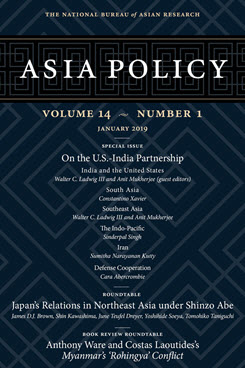Converting Convergence into Cooperation
The United States and India in South Asia
This article examines how the U.S. and India, driven by their converging concerns over China’s rise in the Indo-Pacific, are presented with an opportunity to deepen their cooperation in South Asia.
Executive Summary
MAIN ARGUMENT
Seeking to counter China’s expansionism in South Asia, India’s traditional sphere of influence, New Delhi now partners with several “like-minded” countries to offer an alternative source of infrastructure development and connectivity initiatives. This has opened a window of opportunity for the U.S. to cooperate with India in the region. Based on historical case studies in Nepal, Sri Lanka, and Myanmar, with new evidence from primary sources, this article shows how different strategic priorities, capabilities, and perceptional challenges have at times hindered U.S. and Indian policies from aligning. At the same time, however, the article dispels the common assumption that the U.S. and India have always been locked in an inevitably hostile relationship across the region. A detailed analysis of both states’ approaches to the region since the 1950s shows that, despite significant challenges and differences, there have been instances of policy coordination that are relevant for today’s attempts to facilitate cooperation amid convergence. To work together more efficiently and counter China’s rising leverage in South Asia, India and the U.S. will need to learn from past interactions and focus on their communication and coordination of policies in the region.
POLICY IMPLICATIONS
- The U.S. and India must continue improving communication channels to exchange assessments about the region, especially during crises. This is particularly important to prevent China or third states from playing the two off against each other.
- India and the U.S. should engage in a dialogue to flesh out what sustainable connectivity means in practice, including developing infrastructure and setting criteria to allow businesses to benefit from economic liberalization and the rule of law in South Asia.
- The U.S. and India must keep investing in public diplomacy and outreach across South Asia, stimulating wider domestic debates—especially in Nepal, Bangladesh, and Sri Lanka—about the long-term costs of China’s influence.
Constantino Xavier is a Fellow in Foreign Policy Studies at Brookings India in New Delhi, where he researches India’s foreign policies as a regional power, including the linkages between connectivity, security, and democracy in South Asia.
About Asia Policy
Asia Policy is a peer-reviewed scholarly journal presenting policy-relevant academic research on the Asia-Pacific that draws clear and concise conclusions useful to today’s policymakers. Asia Policy is published quarterly in January, April, July, and October and accepts submissions on a rolling basis. Learn more


